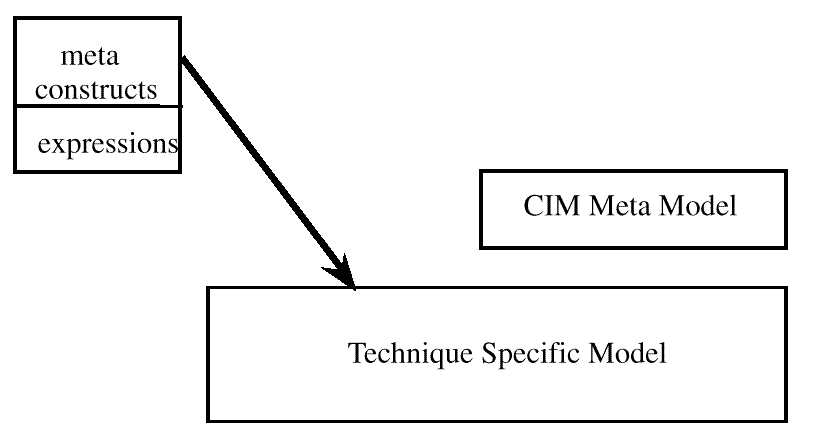
Each of these mappings can be applied when converting the MIF syntax to MOF syntax.
The DMTF uses the management information format of MIF as the metamodel to
The mapping presented here takes the important types that can appear in a MIF file
and then creates classes for them. Thus, component, group, attribute, table, and enum
are expressed in the CIM metamodel as classes. In addition, associations are defined
-
-
DMI attributes -> CIM properties
DMI key attributes -> CIM key properties
DMI groups -> CIM classes
DMI components -> CIM classes
The standard DMI ComponentID group might be recast into a
corresponding CIM class:
-
-
Start Group
Name = "ComponentID"
Class = "DMTF|ComponentID|001"
ID = 1
Description = "This group defines the attributes common to all "
"components. This group is required."
Start Attribute
Name = "Manufacturer"
ID = 1
Description = "Manufacturer of this system."
Access = Read-Only
Storage = Common
Type = DisplayString(64)
Value = ""
End Attribute
Start Attribute
Name = "Product"
ID = 2
Description = "Product name for this system."
Access = Read-Only
Storage = Common
Type = DisplayString(64)
Value = ""
End Attribute
Start Attribute
Name = "Version"
ID = 3
Description = "Version number of this system."
Access = Read-Only
Storage = Specific
Type = DisplayString(64)
Value = ""
End Attribute
Start Attribute
Name = "Serial Number"
ID = 4
Description = "Serial number for this system."
Access = Read-Only
Storage = Specific
Type = DisplayString(64)
Value = ""
End Attribute
Start Attribute
Name = "Installation"
ID = 5
Description = "Component installation time and date."
Access = Read-Only
Storage = Specific
Type = Date
Value = ""
End Attribute
Start Attribute
Name = "Verify"
ID = 6
Description = "A code that provides a level of verification that"
"the component is still installed and working."
Access = Read-Only
Storage = Common
Type = Start ENUM
0 = "An error occurred; check status code."
1 = "This component does not exist."
2 = "Verification is not supported."
3 = "Reserved."
4 = "This component exists, but the functionality is untested."
5 = "This component exists, but the functionality is unknown."
6 = "This component exists, and is not functioning correctly."
7 = "This component exists, and is functioning correctly."
End ENUM
Value = 1
End Attribute
End Group
A corresponding CIM class might be the following. Note that
properties in the example include an ID qualifier to represent the
corresponding DMI attribute's ID. Here, a user-defined qualifier may
be necessary.
-
-
[Name ("ComponentID"), ID (1), Description (
"This group defines the attributes common to all components. "
"This group is required.")]
class DMTF|ComponentID|001 {
[ID (1), Description ("Manufacturer of this system."), maxlen
(64)]
string Manufacturer;
[ID (2), Description ("Product name for this system."), maxlen
(64)]
string Product;
[ID (3), Description ("Version number of this system."), maxlen
(64)]
string Version;
[ID (4), Description ("Serial number for this system."), maxlen
(64)]
string Serial_Number;
[ID (5), Description("Component installation time and date.")]
datetime Installation;
[ID (6), Description("A code that provides a level of verification"
"that the component is still installed and working."),
Value (1)]
string Verify;
};
This is an example of how CIM properties can be supplied by DMI, using
information from the DMI disks group ("DMTF|Disks|002"). For a
hypothetical CIM disk class, the CIM properties are expressed as
shown in
| CIM "Disk" property | Can be sourced from DMI group/attribute |
|---|---|
| StorageType | "MIF.DMTF|Disks|002.1" |
| StorageInterface | "MIF.DMTF|Disks|002.3" |
| RemovableDrive | "MIF.DMTF|Disks|002.6" |
| RemovableMedia | "MIF.DMTF|Disks|002.7" |
| DiskSize | "MIF.DMTF|Disks|002.16" |
| Contents | Next section | Index |